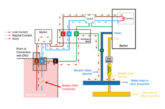
This article looks at Chapter 82 of BS 7671 and embedded renewable sources, either used in conjunction with the existing supply for an installation or as an alternative and independent source of electrical energy forming a prosumer’s low-voltage electrical installation (PEI).
Many consumers have been moving towards energy saving measures over the past few years, and never more so than recently with the increasing costs in energy and the significantly reduced returns provided from feeding back into the Grid.
The increase in the popularity of electric vehicles in line with government targets for the reduction in the burning of fossil fuels for energy generation, and delays in the construction of nuclear power facilities has meant that measures need to be taken to support the increasing energy demands and mitigate stress on the public distribution network.
Amendment 2 of BS 7671:2018 introduced a new Chapter 82; Prosumer’s low voltage electrical installations (PEIs), which contains additional requirements, recommendations and guidance for the design, erection, and verification of many types of low voltage electrical installations included within the scope of BS 7671, and not least, for those installations having local production and storage of electrical energy (see Fig 1).

The intention of Chapter 82 is to ensure that the adopted means of renewable energy source(s) available and operating in a PEI, either in isolation from, or when connected in parallel with, the public supply and used for the dynamic support of power demand to the public distribution network should be made reliable, be able to operate safely, and provide sustainable and efficient use of energy when integrated into the smart grid system.
Additionally, the PEI infrastructure should be compatible with existing and future ways to deliver electrical energy to current-using equipment within the installation and/or to the public distribution network (821).
It is recognised that both the generation of electrical energy from renewable sources such as solar PV and/or wind turbines, and that energy consumption patterns within an installation are intermittent. For this reason, where it is expected that a prosumer’s installation is to be available in ‘Island mode’ and isolated from the grid, or where it is necessary to maximise self-consumption during periods of reduced generation and high current demand, regulation 822.1 recommends that a means to store energy is provided within a PEI.
What is a PEI?
A PEI is a low-voltage electrical installation that can both consume and produce electrical energy, and that may or may not be connected to a public distribution network. A PEI is typically formed by a combination of electrical equipment available within an installation that provides specific functions, including:
I. Supply: Connection to the public distribution network, or local generation including Solar PV, wind turbines and in some instances, electrical energy storage systems (EESS).
II. Distribution system: Depending on the type of PEI, configuration of distribution boards, distribution and final circuits may vary. The delivery method could be through the public distribution system (if agreed with the DNO) or within the separate PEI distribution system.
III. Consumption: Current-using equipment used within the installation. A battery should be considered as both a supply and a load (see note to regulation 823).
IV. Energy management: System monitoring within the installation, allowing switching between available supplies and control of connected loads in the form of load shedding.
PEI operational modes
The integrated electrical energy management system (EEMS) of the PEI is able to switch between the readily available sources of supply. Regulation 824.2 highlights the operational modes that may be adopted and implemented for a particular type of PEI, including:
• Connected mode – operation relies on a connection to the public supply network to enable:
• direct feeding mode: the public distribution network supplies the PEI to consume energy (see Annex B82.1.1, B82.2.1, B82.3.1), and
• reverse feeding mode: the PEI supplies the public distribution network by means of the embedded generation and/or electrical energy storage system (see Annex B82.1.3, B82.2.3, B82.3.3).
• Island mode – the PEI is disconnected and isolated from the public distribution system but remains energised through the solar PV and EESS (if any) (see Annex B82.1.2, B82.2.2, B82.3.2 and Fig 2).

The EEMS
The electrical energy management system (EEMS) is an intelligent device capable of monitoring and controlling many functions (825.1) and may comprise a separate unit or be integrated in other equipment within the PEI. The EEMS can exchange and receive live data with the Distribution System Operator (DSO) in order to interact with the dynamic needs for power demand of the distribution network and current demand within the installation.
In response, the EEMS can adapt the PEI accordingly by means of balancing local consumption, often through load shedding, although other equipment may be required, and diverting electrical energy, depending upon local sources of supply available and their readiness to supply either the installation or support the distribution network.
The EEMS is configured during the initial set-up and contains information relating to the local energy sources attached to the PEI, as agreed within the contractual agreement between the DSO and user. For example, some installations may have a solar PV system combined with a static EESS, whilst other systems may include a connection for an electric vehicle (EV) operating either as a load or mobile EESS.
Appendix 17 of BS 7671 provides additional recommendations for the design and erection of electrical installations having local production and energy storage to optimise the overall efficient use of electricity (821).
The means for optimisation and the application of an energy efficiency measure such as load shedding is typically incorporated as a function within the EEMS controlling the PEI. However, in all cases, the design of the PEI and functions of the EEMS must take account of the needs of the user as priority to the functionality of the PEI over those needs of the DSO for dynamic support of the grid.
Paragraph 17.2 (iv) of Appendix 17 states that provision for a manual override facility enabling the user to take control from such automatic functions should be considered during the system design. This may take the form of a dedicated user interface.
The system design must also ensure that there is no reduction in the availability of an electrical supply or service/operation of the installation below the desired level of the user.
For example, it may include the need to recharge an EV at the property after a long journey. However, at the time, the installation is found to be operating in island mode at the request of the DSO during a period of high demand on the network. To enable EV charging, the EEMS would be required to switch the installation back to connected mode, either automatically, or manually at the request of the user.
It is recognised that a PEI can switch between the intended operational modes at any time (824.2). Although, the form of embedded generation must be automatically synchronised in terms of frequency, phase, and voltage magnitude with the public distribution network before reconnecting back to the grid, and provided that the requirements of Section 551 are met.
The operating modes as described earlier in the article may be adopted for specific types of PEI characterised as:
• Individual – one electrical installation with the ability to both consume and supply electrical energy (see Fig 3).

• Collective – a group of prosumers relying on a communal source of energy generation which is managed for the group (see Fig 4).

• Shared – multiple prosumers coordinating their individual supplies to form a common source of shared energy (see Fig 5).

Summary
This article introduced the concept of a prosumer’s low voltage electrical installation and explained the different types of operational modes within a PEI. Also considered was the electrical energy management system (EEMS), used as a means of monitoring and control of a PEI, while maintaining the user as central to the operation of the PEI.
For more information on NICEIC, click here







